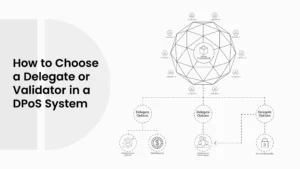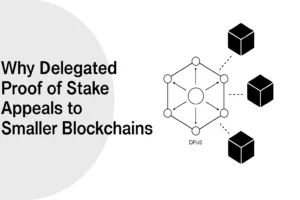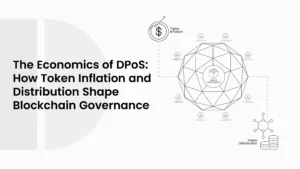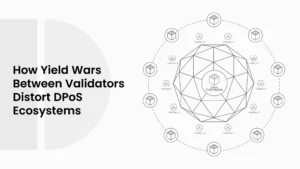Can DPoS and Tendermint Work Together for a Faster Blockchain?
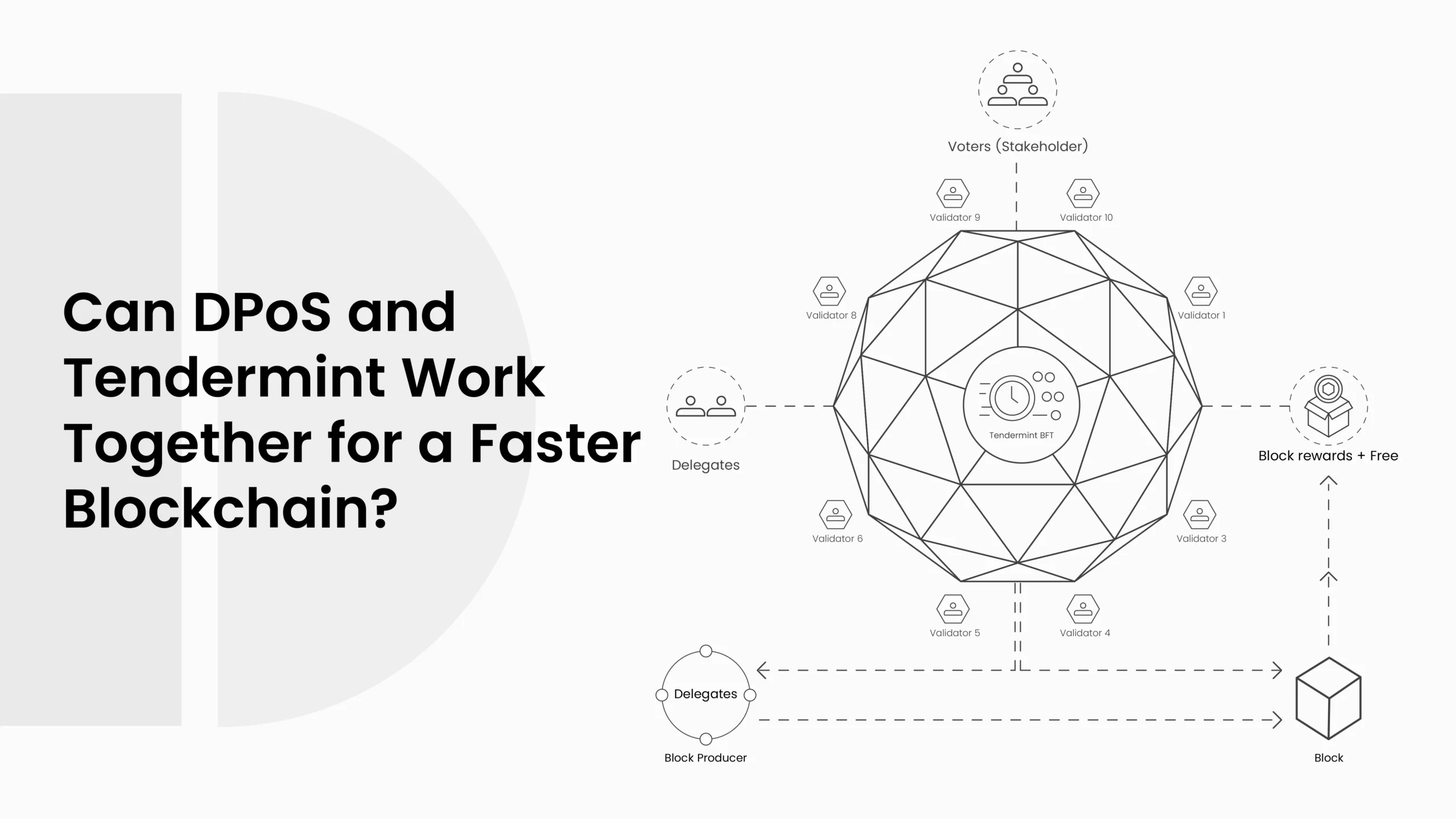
Every blockchain system needs a way for everyone in the network to agree on what is true. This is called consensus. Without the agreement, chaos would prevail, and people would not have a way to distinguish between true and false transactions. Such an agreement can be attained by two well-known systems, Delegated Proof of Stake (DPoS) and Tendermint. They are quick and just, but the question remains as to whether they can collaborate. DPoS is more popular with large networks like EOS and Tron, whereas Tendermint is used in systems like Cosmos. One operates under a voting system with approved validators, the other operates on validators quickly reaching an agreement using Byzantine Fault Tolerance (BFT) rules.
- What is Delegated Proof of Stake (DPoS)?
- What is Tendermint and How it Works
- DPoS vs Tendermint: Are They the Same or Different?
- How DPoS and Tendermint Could Work Together
- Real World Examples: Cosmos, EOS, and Beyond
- Technical Benefits of Integration
- Fast Block Finality
- Lower Energy Use
- Better Governance Control
- Improved Network Throughput
- Challenges in Making Them Work Together
- Security View: How Safe is a DPoS + Tendermint Mix
- Use Case Example: Smart City or IoT Networks
- Conclusion: Balance Between Trust and Speed
- Frequently Asked Questions About DPoS and Tendermint
- What makes DPoS different from Tendermint?
- Can DPoS and Tendermint be used in one blockchain?
- Is Tendermint better than Proof of Work?
- Why do developers like Tendermint?
- What industries can use DPoS + Tendermint?
- Glossary of Key Terms
The big question is: if both focus on trust and speed, can they be used together to improve blockchains? Some researchers, like Arora, Kumar, and Kim (2021), have already tested Tendermint in real systems like vehicular networks and found that it can reduce delay by over 15 percent while improving message trust (Arora et al., 2021). This shows that Tendermint is not only strong but also flexible enough to mix with other systems like DPoS. In this blog, the author will discuss what DPoS and Tendermint actually are, the difference between them, how they function, and how they could co-exist. I hope to make it easy to enable any non-technical person to know what is going on behind the wall, or curtain, of a blockchain.
What is Delegated Proof of Stake (DPoS)?
Delegated Proof of Stake or DPoS is like a digital democracy for blockchains. Rather than having everyone do resource-intensive mining, like in Bitcoin, users of DPoS systems vote in a small number of people called delegates or validators to create the new blocks and verify transactions.
Take a classroom, for example, where the class votes for a few students to keep class attendance. All students have a say in the decision; however, those students who voted simply keep attendance for the week. This makes everything more efficient and faster to verify attendance. The purpose of DPoS is to make all the self-governance of blockchains fair but efficient. It’s a middle ground between Proof of Work (PoW), which uses a lot of power, and Proof of Stake (PoS), which depends only on how many tokens someone owns. In DPoS, your vote counts, even if you don’t have a lot of money. Let’s see how it compares in a simple table:
| Feature | DPoS | PoS | PoW |
| Speed | Very fast | Medium | Slow |
| Energy use | Low | Medium | High |
| Governance | Token voting | Stake weight | Mining power |
| Examples | EOS, Tron, Steem | Cardano, Ethereum 2.0 | Bitcoin |
Because DPoS limits the number of validators, the network doesn’t waste time waiting for thousands of nodes to agree. Fewer validators mean faster block times and higher transaction rates. But it’s not perfect. Since a small group makes decisions, DPoS systems can sometimes look more centralized. Still, it works very well in systems where voting and trust are key.
ALSO READ: How Slashing Designs Help Build Trust in Custom DPoS Chains
What is Tendermint and How it Works
Tendermint is another way to reach an agreement in blockchain networks. It’s a consensus engine that makes sure all computers in the network have the same data, even if some go offline or act badly. You can think of it as the heart of a blockchain system. It’s not about who gets elected like DPoS, but about how the network confirms each block safely and quickly. Tendermint has two main parts:
- Tendermint Core – handles the consensus and communication between nodes.
- ABCI (Application Blockchain Interface) – acts like a translator that lets developers use any programming language to build their blockchain apps.
| Step | Action | Goal |
| Propose | A validator suggests a new block | Start the voting round |
| Prevote | Validators check and vote yes/no | Test agreement |
| Precommit | Validators confirm their final vote | Lock block for commit |
| Commit | Add the block to the chain | Complete the process |
Tendermint uses a system called Byzantine Fault Tolerance (BFT), which means it can still function even if up to one-third of validators fail or act dishonestly. This makes it very secure. Another reason why Tendermint is popular is that it is fast. Most blockchains using it can confirm transactions in just one or two seconds. It’s also flexible; developers can use it to build blockchains for different purposes like finance, gaming, or even IoT networks.
According to Arora et al. (2021) in Applied Sciences, the blockchain based on Tendermint showed 7.8 percent better packet delivery ratio in a simulation executed for connected vehicles, which demonstrates that Tendermint can be applied to real-life scenarios in a very effective way (Arora et al., 2021). To put this in simpler terms: if DPoS is about who gets to speak, Tendermint is about whether everyone hears and agrees.
DPoS vs Tendermint: Are They the Same or Different?
Both DPoS and Tendermint are at first sight very similar. They both employ validators, both are concerned with quick agreement, and neither of them employs heavy mining. Yet the two are distinct. DPoS is a governance model. It is regarding who is chosen in order to confirm blocks. Delegates are selected by the vote of their users. The task of these representatives is to create new blocks and ensure the chain is safe.
Tendermint, on the other hand, is a consensus engine. It doesn’t care how validators are picked. It only cares about how they reach an agreement once they are in the system. So DPoS is like the election system, and Tendermint is the meeting room where those elected members agree on decisions. Here’s an easy comparison:
| Feature | DPoS | Tendermint |
| Type | Governance system | Consensus protocol |
| Focus | Selecting validators | Reaching an agreement on blocks |
| Voting style | Token-based elections | Round-by-round validator voting |
| Network type | Mostly public | Mostly permissioned |
| Example use | EOS, Tron | Cosmos, Binance Chain |
This is why many developers and researchers are now asking if these two can be combined. If DPoS decides who validates and Tendermint manages how they agree, then both systems could fill each other’s gaps. DPoS is known for flexibility and community control, while Tendermint is known for speed and finality. Together, they could make blockchain networks that are both fair and technically strong.
How DPoS and Tendermint Could Work Together
DPoS manages the governance component, as token owners vote and choose validators. Tendermint also takes care of the consensus component; as such, validators reach an agreement on the new block order and ensure that all is sincere and definitive.
In other words, DPoS is the one who will choose those who will validate, whereas Tendermint is the one who will choose how they will validate. Such a combination has the potential to make the blockchain more democratic and efficient. DPoS is a social component of voting, and Tendermint is a technical component of assurance in the form of Byzantine Fault Tolerance. As a combination, these two concepts can balance fairness and safety. Let’s look at a short table showing how these two can cooperate in one system:
| Layer | Technology | Role in Blockchain |
| Governance | DPoS | Chooses active validators through token voting |
| Consensus | Tendermint | Reaches an agreement between validators on each block |
| Application | Custom blockchain logic | Runs transactions and smart contracts |
For example, in a hybrid model, voters could elect a set of 50 validators using DPoS. Once selected, these validators would use Tendermint’s BFT consensus to add new blocks. If one validator acts badly, DPoS voting can remove them later. This setup gives both speed and accountability.
Researchers in blockchain design say this kind of hybrid model could solve many existing issues. DPoS alone can be attacked if too few validators dominate. Tendermint alone might not have a democratic way to select validators. But together, they fill each other’s missing parts (Christidis & Devetsikiotis, 2016).
Real World Examples: Cosmos, EOS, and Beyond
To understand this idea better, it helps to see how today’s blockchains already use one or both systems.
Cosmos runs fully on Tendermint. Every zone in the Cosmos network uses Tendermint Core to agree on blocks. It gives Cosmos fast finality, meaning transactions are confirmed in just seconds. But governance in Cosmos works differently. Token holders use a voting system to approve proposals, but validator selection is still stake-based.
EOS uses DPoS. Token holders vote for 21 block producers. Those producers take turns making blocks. It is very fast but can become centralized because a few validators often stay in power for long periods.
Some other blockchains, like Binance Chain and Kava, use Tendermint with staking logic similar to DPoS. These projects show that the idea of mixing voting-based systems with Tendermint’s consensus already works in practice. Here’s a simple comparison:
| Project | Uses DPoS | Uses Tendermint | Type |
| Cosmos | No | Yes | Modular chain with Tendermint Core |
| EOS | Yes | No | DPoS chain |
| Binance Chain | Partial | Yes | Hybrid PoS/Tendermint |
| Kava | Yes | Yes | DPoS + Tendermint hybrid |
As presented in this table, there is a tendency for many chains to shift to hybrid models. This is the method that is preferred by developers since it provides decentralization alongside fast block confirmations. The Cosmos ecosystem does go so far as to offer a framework known as the Cosmos SDK, which allows anyone to implement their own DPoS or hybrid network over Tendermint Core. This is why Cosmos is also referred to as the Internet of Blockchains.
ALSO READ: Debugging Validator Downtime in DPoS Networks: A Beginner’s Guide to Node Stability
Technical Benefits of Integration
When DPoS and Tendermint work together, the system becomes both fast and reliable. Below are some technical benefits explained in simple terms.
Fast Block Finality
Tendermint can finalize a block in one or two seconds. Once it’s done, the block can’t be changed. In DPoS networks, block finality sometimes depends on later confirmations, but with Tendermint’s design, blocks are final instantly.
Lower Energy Use
Both DPoS and Tendermint avoid heavy mining. That means less power use and more eco-friendly operation compared to Proof of Work systems like Bitcoin.
Better Governance Control
DPoS allows community members to replace or vote out bad validators. That adds a layer of accountability on top of Tendermint’s consensus.
Improved Network Throughput
In the 2021 MDPI study on vehicular networks, Tendermint improved the packet delivery ratio by 7.8% and lowered the end-to-end delay by 15.6%. That shows how well it handles high-speed data (Arora et al., 2021).
Challenges in Making Them Work Together
Even though the idea looks perfect on paper, it’s not that easy to make DPoS and Tendermint run together smoothly. There are several real challenges. Validator overlap is one issue. DPoS chooses validators through votes, while Tendermint needs fixed validator sets for each round of consensus. When validators are frequently replaced by new votes, Tendermint’s stability can be affected. Double voting can also become a risk. If validator rotation happens while a round of Tendermint consensus is still active, some validators might try to sign multiple rounds, leading to confusion or forks.
Another problem is governance timing. DPoS elections might take hours or days, while Tendermint operates in seconds. So the two systems need a smart synchronization process to stay aligned. Researchers are trying different solutions for this. One option is to use epoch-based validator rotation, where DPoS updates validators only after a full Tendermint epoch ends. This keeps both layers in sync. Another is to use multi-signature governance smart contracts, which handle validator changes without interrupting block production.
Security View: How Safe is a DPoS + Tendermint Mix
The first question that comes to mind is about safety. Can two systems working together still stay secure? The short answer is yes, but it depends on how the connection between governance and consensus is made.
Tendermint is built on Byzantine Fault Tolerance (BFT). That means even if one-third of validators go offline or act badly, the system will still run fine. The validators sign every step in the process, so no block can be added without two-thirds of honest votes.
DPoS adds another layer of protection. It lets people in the network vote out bad validators. If a validator misbehaves or stops validating, the voters can remove it. This prevents long-term damage. Here’s a simple table showing how both help with security:
| Security Layer | Handled By | Protection Type |
| Consensus integrity | Tendermint | BFT voting prevents fake blocks |
| Validator accountability | DPoS | The community can vote out bad actors |
| Privacy of nodes | Tendermint | Signed messages hide the validator identity |
| Governance abuse | DPoS | Token voting limits power concentration |
A study by Arora, Kumar, and Kim (2021) showed that Tendermint was able to handle malicious nodes in a network by filtering false data and lowering message spoofing by over 15%. This means that when combined with a voting system like DPoS, the network could resist both technical and social-level attacks. Together, they create a dual-shield model. Tendermint protects the system from bad code and failed nodes, while DPoS protects it from unfair human control.
Use Case Example: Smart City or IoT Networks
Let’s take an easy example of how DPoS and Tendermint could help in real life. Imagine a smart city where thousands of devices talk to each other: traffic lights, electric cars, sensors, and drones. These devices need to share data fast and safely.
In such networks, you can’t use slow or power-hungry systems like Bitcoin’s Proof of Work. You need something fast, secure, and light. That’s where the hybrid model of DPoS + Tendermint fits perfectly.
- DPoS can be used to pick which city nodes (maybe local servers or trusted devices) act as validators.
- Tendermint makes sure that those validators agree on each block of data before it’s shared city-wide.
In a test done by Arora et al. (2021), when Tendermint was used in vehicle-to-vehicle networks, it improved packet delivery ratio (PDR) and reduced latency compared to older methods like Proof of Work. Below is an example table of what results could look like if applied in a smart city:
| Parameter | DPoS + Tendermint | Proof of Work |
| Packet Delivery Ratio | 92% | 85% |
| End-to-End Delay | 0.15 seconds | 0.30 seconds |
| Energy Use | Low | High |
| Fault Tolerance | High | Medium |
This combination makes the devices in the city remain connected even when some of them go offline or become errant. It also renders data more credible. Outside of cities, this architecture may be used in IoT systems, smart factories, or even cross-border payment networks where the speed and reliability are more important than the raw mining power.
ALSO READ: A Beginner’s Guide: Building a Fair Token Distribution System in DPoS Networks
Conclusion: Balance Between Trust and Speed
So, can DPoS and Tendermint work together? The answer looks like a clear yes. Both were made for similar goals: trust, speed, and efficiency, but from different directions. DPoS focuses on who decides, while Tendermint focuses on how decisions are made. When joined, they form a balanced structure. DPoS adds the human voting side, giving the network fairness. Tendermint adds the machine logic side, giving it technical safety. Together, they create a blockchain system that can scale fast without losing trust.
Cosmos uses Tendermint for fast finality, and EOS uses DPoS for governance. Combining these two ideas could lead to even stronger blockchains that are ready for complex tasks like IoT, finance, and smart city infrastructure. As researchers like Arora, Kumar, and Kim (2021) showed, Tendermint already improves system reliability and speed in decentralized networks. If combined with DPoS governance, the future of blockchain, beyond DPoS vs PoS or PoW, could be both fast and fully accountable to its users.
Frequently Asked Questions About DPoS and Tendermint
What makes DPoS different from Tendermint?
DPoS focuses on how validators are chosen, using community votes. Tendermint focuses on how validators agree on adding new blocks. They solve different problems but can work together very well.
Can DPoS and Tendermint be used in one blockchain?
Yes, they can. DPoS can manage the election of validators while Tendermint handles the consensus part. This hybrid system gives better performance and stronger fairness.
Is Tendermint better than Proof of Work?
Yes, for most modern systems it is. Tendermint does not need heavy mining, so it’s faster, cheaper, and uses less power compared to Proof of Work like Bitcoin.
Why do developers like Tendermint?
Because it’s modular and easy to use. Developers can build apps in any programming language using its ABCI interface and still use its secure consensus system.
What industries can use DPoS + Tendermint?
Smart cities, Internet of Things (IoT), finance, supply chain, and even digital identity systems can benefit from this hybrid model because it provides speed and security together.
Glossary of Key Terms
Blockchain:
A digital record of transactions shared across computers, used to make data secure and tamper-proof.
Consensus Mechanism:
A system that helps all nodes in a blockchain agree on what data is correct.
DPoS (Delegated Proof of Stake):
A consensus model where users vote for trusted validators to make decisions and add blocks.
Tendermint:
A Byzantine Fault Tolerant (BFT) consensus engine that ensures fast and safe agreement between nodes.
Validator:
A trusted node or participant that checks and approves transactions before adding them to the blockchain.
Governance Layer:
The part of a blockchain system where community members vote or make decisions.
BFT (Byzantine Fault Tolerance):
A security system that allows the network to keep running even if some participants act wrongly or fail.
TPS (Transactions Per Second):
A measure of how many transactions a blockchain can process each second.

